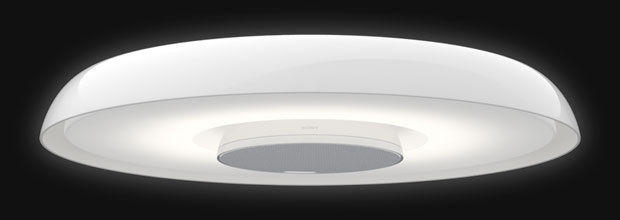Sony this week announced its Multifunctional Light, a ceiling lamp that’s kitted out with sensors to talk to smart things.
It includes sensors for motion, illumination, temperature and humidity. There’s also the requisite WiFi radio, a memory card slot, a condenser microphone, and an infrared controller for air conditioners.
The lamp form factor offers convenient placement, said Sony Electronics spokesperson John Dolak. “The device will be used to control other appliances and detect various things in or about a room, and we gave thought to where we could install it so that it would work as well as possible.”
“Ultimately, we decided to bring the platform to life in the form of a ceiling light, since the ceiling generally has few obstructions that might impede the effective operation of the Multifunctional Light,” he told TechNewsWorld.
As for details on Sony’s strategy with the doughnut-shaped Multifunctional Light, Dolak declined to share specifics. The company plans to launch the smart hub in Japan during the first half of 2016.
“For the time being, we will focus only on the Japanese market, given that this is a new business venture and a new market for us,” he said. “Therefore we have nothing to announce about other areas at this time.”
In Its Place
Sony’s approach of building a hub meant to hang out of the way on a ceiling makes a lot of sense, said Patrick Moorhead, president and principal analyst atMoor Insights & Strategy. It’s targeting the Japanese market, where square footage comes at a premium.
“Being fixed to the ceiling, it has line of sight to other devices it can control, which means there’s less of a chance that a signal would get blocked by a wall or thick piece of furniture,” he told TechNewsWorld.
“It also does a good job, unlike a Nest, determining if a person is in the room. It seems as if every tech company wants to create their own smart hub,” Moorhead added.
Come Together
Amazon, Apple, EasyAcc, GE, Google, Huawei, Iris, Kingwin, Orico, Samsung, SmartThings, Telus, Vera and Wink are just some of the companies offering their own smart home hubs.
Getting all those smart hubs to play nice, or even talk to one another, is likely a major factor hindering the adoption of connected home ecosystems. Home automation still has a way to go, as it’s in the “third inning of a nine-inning game,” Moorhead noted.
“Today, we have ecosystems of devices that can work together (HomeKit, AllSeen, Nest, Insteon),” he said, “but until we see improved interoperability between all devices, lower prices, guaranteed privacy and security, and improved simplicity, home automation will be for the home enthusiasts and technophiles, not the general consumer.”




















































